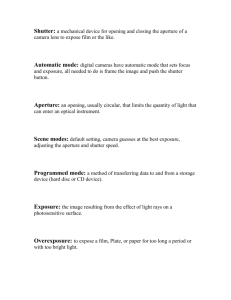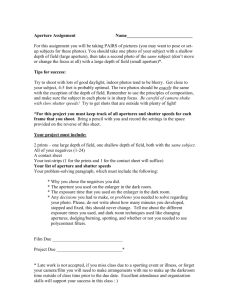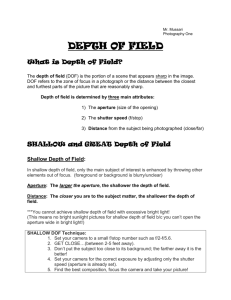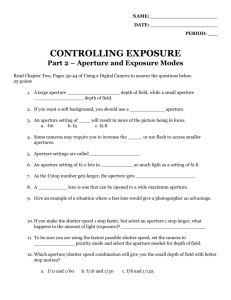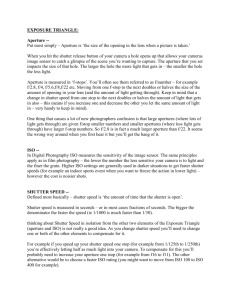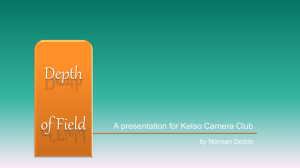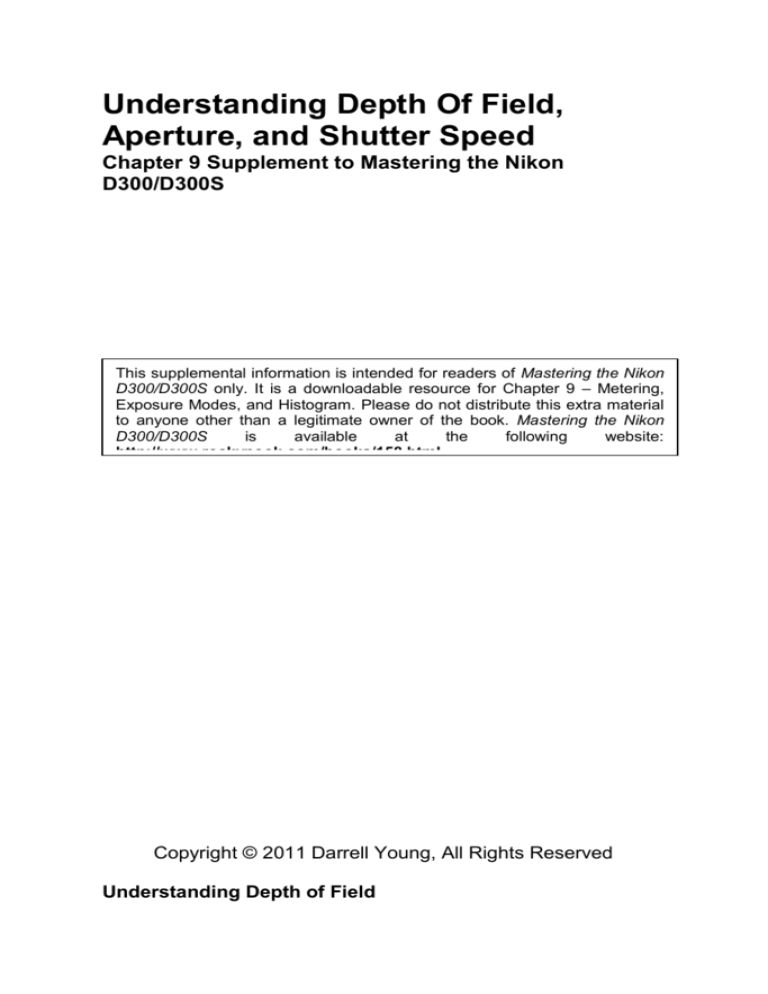
Understanding Depth Of Field,
Aperture, and Shutter Speed
Chapter 9 Supplement to Mastering the Nikon
D300/D300S
This supplemental information is intended for readers of Mastering the Nikon
D300/D300S only. It is a downloadable resource for Chapter 9 – Metering,
Exposure Modes, and Histogram. Please do not distribute this extra material
to anyone other than a legitimate owner of the book. Mastering the Nikon
D300/D300S
is
available
at
the
following
website:
http://www.rockynook.com/books/158.html
Copyright © 2011 Darrell Young, All Rights Reserved
Understanding Depth of Field
2
Depth of field is one of those things that confuse a lot of new DSLR users. Yet, it
is very important! I'm going to attempt to explain this concept using pictures. This
topic transcends the actual DSLR being used. In fact, my illustrations were created
with my trusty old Nikon D2X.
Let's say you are taking a picture of a friend who is standing 6 feet (2m) away
from you. About 6 feet behind your friend is another person. There’s also a third
person standing about 6 feet behind the second person. Three people total, each
about 6 feet apart, with the friend in front (see FIG 1A).
You are shooting with a 50mm f/1.8 lens. You focus on your friend's face, the
young lady in red, and take a picture. It looks like the image in FIG 1A.
FIG 1A – Three kids at f/1.8, shutter speed at 1/6000
F/1.8 is an aperture number. An aperture is simply an opening in the front of
your lens controlled by blades. It lets light come in through the lens to expose your
D300(S)'s sensor. You can't see the aperture when you look in the front of your
lens (usually) since your D300(S) allows you to focus with the aperture blades
wide open and out of the way.
The aperture closes down to its selected setting when you press the Shutter–
release button to take your picture, or when you press the Depth-of-field preview
button. That's why the viewfinder often gets darker when you press the Depth-offield preview button on your camera.
3
Apertures on your zoom lens probably start at about f/3.5 (big aperture), and
stop at f/22 (small aperture). The bigger the aperture can get (the larger the
opening) the faster the lens is considered. A fast lens is a lens with a big maximum
aperture opening. The 50mm f/1.8 lens is a fast lens.
Notice that in FIG 1A your friend (in red) is in sharp focus. The girl standing
behind her, to the right, is not in focus, nor is the young lad even farther away to
the left. This is the result of shooting with a big aperture. F/1.8 is a big opening in
the front of your lens. It causes the depth of field, or "zone of sharp focus", to be
shallow. Only the girl in front is in focus at f/1.8. Not much else is in focus, so
there is very little depth of field. The depth of field in this picture is much less than
3 feet (.91m) deep; it’s probably more like 1.5 feet (.45m).
So what would happen if we closed the aperture down (stopped down) to a
medium aperture like f/8? FIG 1B shows what that will do to the depth of field.
FIG 1B – Three kids at f/8, shutter speed at 1/500
Remember, you are focused on the girl in front, and at f/1.8 (a big, fast
aperture) the others were out of focus. Without changing your focus in any way,
you adjusted your aperture to f/8. Something changed!
You focused your camera on the girl in front, but now the girl to the right is
sharp too, even though you did not change your focus control. The depth of field
(zone of sharp focus) now extends past the girl in front and covers the girl in back.
It got deeper.
4
However, also notice that the boy to the left is still not in focus. The
background is not in focus either. The depth of field is deeper, but still not deep
enough to cover all your subjects.
This image is the result of a medium aperture opening (f/8), not fast (f/1.8),
and not slow (f/22). Now, let's consider what happens if we stop down, or close the
aperture to a small opening like f/22 (see FIG 1C).
FIG 1C – Three kids at f/22, shutter speed at 1/40
Aha! Now everything in the picture is sharp. An aperture as slow and small as
f/22 makes it easy to get sharp focus. Remember, you focused on the girl in front
in all these pictures. At first, only the girl in red was in focus (f/1.8), and as the
aperture got smaller (see FIG 2), more and more of the surroundings came into
sharp focus (f/8 and f/22). We’ll examine the aperture in the next section.
So, depth of field is simply the zone of sharp focus. It extends in front of and
behind your focused subject, and gets deeper in both directions, toward the camera
and away from it, as you stop down your lens. If you set your camera to Aperture
priority auto (or Manual mode), you can adjust the aperture to control what is in
focus in your pictures.
Don't forget that in this case you are also making trade-offs. All three images
were shot at ISO 100, and once I started using the smaller apertures, the camera
needed to compensate by using longer exposure times. The f/1.8 shot was at
1/6000 second. The f/8 shot was at 1/500 second. The f/22 final image required an
exposure of merely 1/40 second.
5
This was fairly easy to pull off under sunny skies with stationary subjects, but
you can see where the shutter speed exposure compensations could get
troublesome if these three subjects were playing ball or jumping around. This is
when the experienced photographer takes advantage of Manual mode.
Understanding Aperture and Shutter Speed
The Nikon D300(S) allows you to take excellent pictures without understanding
how the aperture and shutter speed works, or what a focal length is. Why, then,
have I included a chapter section devoted to that subject?
Many D300(S) owners are interested in going beyond basic photography.
Previously, they might have been using a camera with fewer features, or even a
point and shoot model. The D300(S) is a semi-professional camera, in that it
provides a much finer degree of control over the final look of the image, and is
robustly built. Many professionals use the Nikon D300(S) as a “carry camera” for
when they want to go out and shoot for fun, or even as a backup camera in case
their main pro-level camera develops a problem.
Since many need just a little help with how these most basic of camera and
lens functions work, I decided to include this chapter. Even if you feel that you
understand the concepts well enough, why not do a quick review. Maybe you’ll
learn something helpful!
The relationship between the aperture and shutter speed seems to be a difficult
thing to understand for quite a few photographers. Yet, it is one of the most
important concepts to have knowledge of, since it affects how an image looks in a
major way.
In this chapter, we’ll look at the aperture and shutter speed settings in a
comprehensive way. Then, we’ll explore how the relationship between the two
settings changes the appearance of an image. Finally, we’ll consider how the
various focal lengths of your lenses will affect your choice of lens.
Understanding the Camera’s Aperture
You’ve probably read about or seen what’s called a pinhole camera. A few years
back many people liked to experiment with them for fun and education. All one
needed was a box or tube, a piece of film, and a pinhole to use instead of a lens.
The concept involves fastening a piece of film on an inside wall of a lighttight box, and pricking a tiny pinhole in the opposite wall of the box. This will
later allow light to shine through the pinhole onto the film on the opposite side. To
use the pinhole camera you temporarily cover the pinhole, take the box out into the
6
sunlight, place it in front of an interesting scene, uncover the pinhole, and leave for
while.
When you return, you cover the pinhole, go into a darkroom, cut the box open,
and develop the film. If your pinhole was the right size for the amount of time the
light was shining on the film through the pinhole, then you’ll have a nice image
taken in a very basic way. If you guessed wrong about the amount of time you let
the light shine through the pinhole onto the film, the image will be either over or
underexposed.
It seems a lot easier to use your D300(S) instead of a pinhole camera, doesn’t
it? While it might be fun to use a pinhole camera a few times, it certainly wouldn’t
allow you to take the wide range of beautiful images you’ve been getting from
your complex digital camera. However, the D300(S) works in a similar way to the
basic pinhole camera. The difference is variability. You can vary the size of the
“pinhole” with the D300(S).
With the pinhole camera, if you wanted to leave the box out in the sun for a
longer period, you’d make a very small pinhole, so only a little light shines on the
film. If you wanted to leave the box out in the sun for a shorter period, you’d
make the pinhole bigger so that more light would hit the film.
That’s the concept of an aperture, a variably-sized pinhole. Instead of a hole in
a box with film taped to one wall, you have a light-tight camera “box” with a lens
having aperture blades that allow you to vary the size of the pinhole. Instead of
shining light on a piece film you have a digital sensor.
On the next page is a sample of six lenses with the shutter blades set to
various aperture sizes (see FIG 2).
7
We are looking at the business end of the lens, which would normally be
pointed at the subject:
FIG 2 – Various aperture sizes seen while looking in the front of a lens
If you look at the front of your lens, with the lens cap off, you’ll see the actual
maximum aperture of your camera. Hold your D300(S) so that you can look from
the front of your lens from about half an arm’s length away. Make sure that
something bright is behind the eyepiece on the back of the camera. You can
actually see through the front of your lens, right through the rear eyepiece of the
camera. It’s sort of like the time you looked through a pair of binoculars
backwards when you were a child. Everything was small and distant, but you
could see things.
The hole you see behind the glass of the lens is the biggest aperture, or largest
pinhole, your D300(S) can use with the particular lens mounted on the camera.
Basically, the hole in the lens is your camera’s “aperture.”
Using the Aperture and Shutter Speed Together for Great Pictures
While the camera’s aperture is concerned with how much light gets to the image
sensor, the shutter speed is concerned with how long the light shines on the sensor.
In upcoming FIG 4, we see a test image with three exposures of the same
subject. The first exposure is underexposed (too dark), the second exposure is just
right, and the third exposure is overexposed (too light).
8
You must understand how to control both depth of field (aperture) and subject
movement (shutter speed) in your pictures. Which is most important? That varies
with the type of subject you are shooting.
FIG 3 - Flying bird stopped with fast shutter speed.
Let’s say you are taking a picture of a bird flying through the air (see FIG 3).
Of course, you want the bird to have a good focus covering its eye, body, and both
wings, if possible. You need enough depth of field to be able to focus on the bird’s
eye, and still get the rest of him in the zone of sharp focus. You could set a small
aperture, which you know will give you a nice deep depth of field so that all the
bird is in focus.
However, when you use a small aperture for deep depth of field, the opening
the aperture blades form is rather small, and not much light gets into the camera.
So, to compensate you’ll need to let the light come in for a longer time period,
which means using a slower shutter speed. Unfortunately, a slow shutter speed
means the bird will blur as it flies through the air. You’ve got yourself a real
quandary!
How can you balance your need for stopping action (a fast shutter speed), with
your need to keep all parts of your subject in focus (a small aperture)? Great
question! Let’s find an answer.
Now, let’s say you are taking a picture of a beautiful scenic view of the
mountains. You need deep depth of field to cover the distance from up close, to
out past the mountain ridges, which requires using a small aperture. You also want
9
to keep the wind from blowing the tree limbs and blurring them, so you want a
faster shutter speed.
This quandary is what makes photography a learned skill. We are always
balancing our need for depth of field, with our need to stop motion. When there’s
a lot of light, like on a bright sunny day, there may be enough light to have a small
aperture and a fast shutter speed, which gives us deep depth of field and stop
motion capability. However, if there is less light on our subject, we can’t have
both.
We can artificially make our cameras more sensitive to light by raising the
ISO sensitivity of the sensor. In the old days we called it “film speed.” That can be
helpful, but when we take our camera much above the native ISO sensitivity (200),
we start introducing digital artifacts called noise into our picture. We had the same
results with very high speed films, and we called it “grain.” High ISO sensitivity
can create so much noise that our image is no longer very nice. So, higher ISO
sensitivity is only used in an emergency when the shot must be acquired at all
costs.
What we have to learn to do is to balance our shutter speed and aperture
according to the most important thing we are trying to accomplish. What do you
think is more important in our flying bird example (see FIG 3), mentioned
previously? Should every part of the bird be in critical focus—or do we want to
stop the motion of the bird flying through the air? Clearly, if the bird is blurry
from movement it doesn’t matter if we have good focus and depth of field, does it?
So, in the bird example the most important thing is a fast shutter speed. We have to
use whatever shutter speed will stop the bird’s movement, even if we have to
sacrifice some of our depth of field. In other words, we’ll need to open the
aperture to let enough light in so that we can limit the time the light comes in. We
need a fast shutter speed, since that limits the time and can stop action.
In our mountain scene example, the mountain is not moving very fast, is it?
So, the most important thing in that picture is that we have as much depth of field
as possible. We want everything from the foreground all the way out to the far
distance to be in good focus. We have to use a small aperture for depth of field—
letting in less light—which means our shutter speed must be slower to let the light
come in longer. We still desire a shutter speed fast enough to keep the limbs from
blowing, but that’s not as important overall as the deep depth of field.
In order to enjoy our pictures, they must be exposed properly in the first place.
So, we’ll have to learn how to balance aperture and shutter speed to get a proper
exposure, while still capturing the image in the best way for the subject.
10
Let’s discuss how a correct exposure is made by using a combination of
aperture and shutter speed. We’ll use an imaginary amount of light called “units.”
In FIG 4, we see a picture that takes 10 units of light to properly expose our
subject. The picture with 10 units is correctly exposed, while the other two are
not. How can we get a good “10 unit” exposure and make sure we have good
depth of field and subject movement control?
FIG 4 - Imaginary Units of Light
We put our camera in Manual exposure mode, and focus on the scene above.
The light meter reports that to get 10 units of light we need a shutter speed of
1/500s at an aperture of f/2. Now think about this a minute. At f/2, a big aperture,
we will have very little depth of field. For sure, the limbs blowing in the wind will
be stopped since the shutter speed is so fast at 1/500s, but the depth of field will be
so shallow that our mountains in the distance will not be in focus.
Let me show you a series of exposure amounts that all give us exactly 10 of
our imaginary “units” of light.
Exposure amount 1:
Exposure amount 2:
Exposure amount 3:
Exposure amount 4:
1/500s at f/2
1/125s at f/4
1/30s at f/8
1/8s at f/16
Our light meter tells us that at our current setting (1/500s at f2) gives us a
good exposure, but we want more depth of field for a good distant focus. What
can we do? We can select one of the other Exposure amounts in our list with a
better aperture for our needs.
Which is best? Well, Exposure amount 1 (aperture f/2) will not work, since
the depth of field is too shallow. Exposure amount 2 (aperture f/4) is better but
only marginally so. Exposure amount 3 (aperture f/8) is getting much better, but
since our distance is so great, still may not provide deep enough depth of field to
reach all the way out to infinity while keeping the foreground sharp, too.
It looks like our solution is to use Exposure amount 4 (aperture f/16), which
gives us a good aperture for deep depth of field, and should cover our scene well.
However, the shutter speed is so slow at 1/8th of a second that we will blur the
11
image from camera movement if we try to hand hold the camera while taking the
picture.
What’s our solution?
1.
2.
Go ahead and use Exposure amount 3 (aperture f/8), since it provides
good depth of field. However, at 1/30th of a second it’s hard to get a
sharp image due to camera shake, so you’ll have to be very careful and
brace yourself, or
Put your camera on a tripod and use the best value—Exposure amount 4,
(aperture f/16)—to keep the image sharp from foreground to distant
mountains. It is nearly impossible to get a sharp image at a shutter speed
of 1/8th of a second, so we must use a tripod at speeds this slow!
The whole point of inventing this imaginary “10 units of light” exposure
system is to show you that you can arrive at a correct exposure using combinations
of different aperture and shutter speed settings. In the real world, there are no
“units” of light, just a correct or incorrect exposure. Our imaginary “10 units of
light” simply represents a correct exposure.
1/30s at f/8 gives the image a correct exposure. 1/8s at f/16 provides exactly
the same amount of light for a great exposure. 1/8s at f/16 is best for the mountain
scene because the f/16 aperture gives so much depth of field and deep focus from
foreground to infinity.
A Little More Exposure Detail
Let’s play with our exposure amounts for a bit until this makes sense. I’ll explain
why 1/30s at f/8 and 1/8s at f/16 are exactly the same amount of exposure, and
why either one will give a “10 unit” well-exposed picture, like in FIG 4. Here’s
why I used the imaginary units of light—to represent how light or exposure is cut
in half or doubled by either the aperture or shutter speed.
If 1/125s at f/8 lets in 10 units of light, how many units would 1/125s at f/11
let in?
Remember, when the aperture number gets bigger, the aperture opening gets
smaller. Since f/11 is one half the aperture size of f/8, it will only let in one half as
much light.
1/125s at f/11 would then only give us 5 units of light—or half of what’s
needed—and our exposure would be dark, like in FIG 4’s underexposed “5 Unit”
picture.
12
1/125s at f/8 = 10 Units
1/125s at f/11 = 5 Units (aperture is half the size, so lets in half as much
light)
The exposure above uses the same shutter speed, but the second exposure has
an aperture half the size, and only lets in 5 units or half as much light. How can we
compensate so that we get back to 10 units of light, without changing our aperture?
We’ll have to change the shutter speed, too! Since we’ve cut our light in half by
using a smaller aperture opening, what would happen if we held the smaller
aperture open for twice as long?
Aha! Holding the half-sized f/11 aperture open for twice as long—1/60th of a
second—gives us exactly the same amount of light as an aperture opening of f/8 at
1/125th of a second. 1/60th of a second is twice as much time as 1/125th of a
second. So, 1/60s at f/11 is half the light let into the camera for double the time;
an equivalent exposure.
1/125s at f/8 = 10 Units
1/60s at f/11 = 10 Units (aperture half sized, shutter speed twice the time)
In other words—we’ve changed it so that our shutter speed is twice as long.
Why? Since the aperture is half the size, we must allow more time for the light to
come into the camera, by increasing the length of time the shutter is open. We
double the time the shutter is open, putting light through the half-sized f/11
aperture for twice as long. That gives us our imaginary 10 units of light, for a
correct exposure.
General Shutter Speed/Aperture Exposure Rule
To arrive at a similar exposure equivalency you have to first use the light meter to
get a correct exposure reading. Then you think about what the aperture/shutter
speed combination will give you. Do you need a faster shutter speed to control
motion? Do you need a smaller aperture to have more depth of field?
Only you can make those decisions. The camera just suggests a combination
that will give you a correct exposure, nothing more—unless you are using Auto
exposure mode or one of the Scene modes—which makes the camera decide for
you.
Here’s a general rule for those using exposure modes A, S, or M (on Mode
dial):
1.
Get an accurate meter reading. (Use the camera’s histogram readout
too.)
13
2.
Decide whether you need an aperture or shutter speed that differs from
what the meter recommends. You might want more or less depth of field
(aperture), or want to stop or blur motion (shutter speed).
3.
Let’s say the camera suggested 1/125s at f/8 for a good exposure, but you
want a faster shutter speed to stop action. If you select a shutter speed
one step faster, or 1/250s, which cuts the exposure to the sensor by half,
you must open the aperture to let in more light. In other words, if you set
the shutter speed one step higher (removes light), you’ll need to open the
aperture one step larger too (adds light). So if your original exposure was
1/125s at f/8, and you select 1/250s instead, simply open the aperture to
f/5.6, and you get the same amount of exposure. In other words, by
increasing your shutter speed by one step, you cut the time the light
comes into the camera by half, so there is only half as much light that
gets to the sensor. To compensate, you open the aperture to twice the
previous size, so that twice as much light shines on the sensor. You have
the exact same exposure with a different combination of aperture/shutter
speed. 1/125s at f/8 equals 1/250s at f/5.6.
4.
Likewise, if you wanted more depth of field than the metered amount of
1/125s at f/8 would allow, you could close the aperture to the smaller size
of f/11 (stop down). The aperture f/11 lets in exactly half as much light
as f/8. So, your exposure is exactly one half of the suggested good
exposure. To compensate, you could use the slower shutter speed of
1/60s, which lets light in twice as long. You are again giving the camera
exactly the amount of light that it needs to make a good exposure, but
have more depth of field. In other words, if you close the aperture by one
step (removes light), you’ll need to slow the shutter speed by one step
(adds light). F/11 at 1/60s equals f/8 at 1/125s.
.
The two considerations are “how much,” and “how long.” Use your aperture
to control how much light gets onto the sensor. Use your shutter speed to control
how long the light gets to the sensor. Balance the two for a correct exposure!
Aperture and Shutter Speed Chart
In FIG 5 you’ll find an Aperture & Shutter Speed Equivalency Chart for your use
in figuring out how the relationships we’ve discussed above work, but in a more
visual way.
14
FIG 5 - Aperture and Shutter Speed Equivalency Chart
To use the chart you simply select a certain aperture and shutter speed
combination. For instance, let’s use 1/15s at f/5.6. Notice on the chart the orangecolored f/stops run from f/1.4 to f/22. Put your finger over on the f/5.6 position
(5.6). Just below there you’ll see the shutter speed of 1/15s (15). Put your finger
on the shutter speed of 15. Move it to the left one space to 30 or 1/30s. You’ll
notice that above the 30 is an orange 4. The 4 represents f/4. Now this is
important—f5.6 at 1/15s is exactly the same exposure as f/4 at 1/30s.
If you follow this out to the end of the chart, you’ll see that f/5.6 at 1/15s is
equal to f/8 at 1/8s. Also, f/11 at 1/4s is also equal to f/5.6 at 1/15s. Any of the
numbers along the top (f/stops) of the chart matched with the number below
(shutter speed) is exactly the same exposure. To make this clearer, I am going to
list several exposures that are exactly the same, and bring the same amount of light
into the camera:
1/250s at f/1.4
1/125s at f/2
1/60s at f/2.8
1/30s at f/4
As long as you keep your finger in the same row of shutter speeds, the
aperture’s above will give you an equivalent exposure. Let’s switch to a new row
of shutter speeds. Find the f/5.6 f/stop and look down the column until you find
1/125s (125). Using the same logic as before, here are more exposures that
provide exactly the same amount of light to the camera’s sensor:
1/125s at f/5.6
1/250s at f/4
1/500s at f/2.8
1/1000s at f/2
15
If you play with this chart for a while, you will begin to see how flexible your
camera is in giving you so many choices of apertures and shutter speeds. Now you
can choose just the right aperture for the best depth of Field in your image. Or,
you can choose just the right shutter speed to stop action or allow blurred
movement in your picture.
By using this chart and exercising your new knowledge while taking pictures,
you’ll soon become comfortable with the ideas expressed in this chapter. You’ll
have control of your camera in its manual modes, and much finer control over how
your images “turn out.” In fact, no one will be able to say, “That one turned out
well.” You’ll be able to look at them and say, “It didn’t just turn out that way, I
did it on purpose!”

